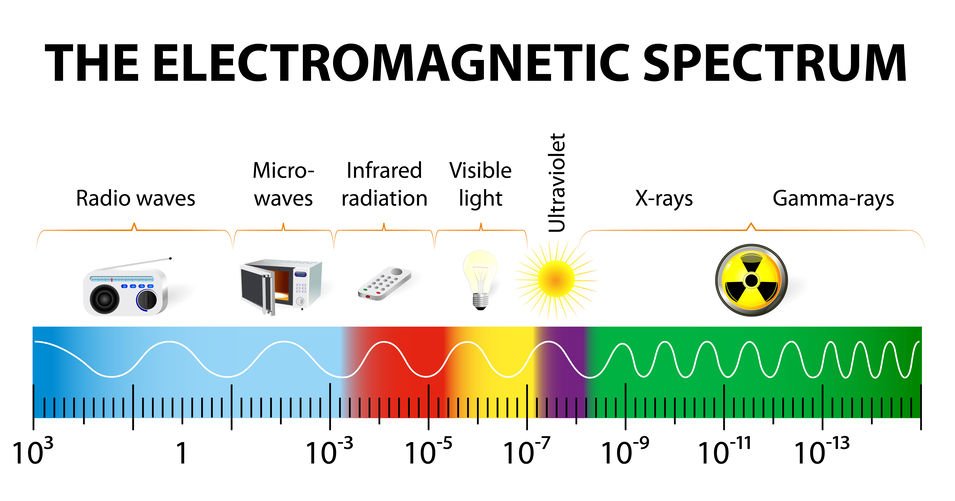On April 3, 1973, the first mobile phone was created. Since then, cell phone technology has…
Solar Radiation vs. Manmade: What’s the Difference?

*We may earn a commission for purchases made using our links. Please see our disclosure to learn more.
One question that comes up frequently is whether or not solar radiation differs from manmade EMFs.
Header
The answer is a definite ‘YES.’ Solar radiation is made up of completely different types of radiation than manmade EMFs. That means they are totally different wavelengths and frequencies, and likely have a different impact on the body.
To help drive that point home, we’re going to fully dive into exactly what solar radiation and manmade EMFs are and how they are different. If you’ve ever wondered why those who are concerned with EMFs don’t usually worry about sunlight, this one’s for you.
The electromagnetic spectrum
To understand what solar and manmade EMFs are, it’s first helpful to have an understanding of the electromagnetic spectrum. At one end of the spectrum, you have extra-low frequency (ELF) EMF radiation, RF-EMF radiation, microwaves, and infrared radiation — basically, all forms of non-ionizing radiation. In the center, there is visible light. On the other end of the spectrum, there is ultraviolet (UV) light, x-rays, and gamma rays — all forms of ionizing radiation.
All electromagnetic radiation has an electric and magnetic field — hence the name. However, each type behaves differently and can cause different physiological responses.
What is solar radiation?
Solar radiation is radiation that is produced by the sun. It actually consists of three different types of radiation.
- Ultraviolet radiation.
- Infrared radiation.
- Photosynthetically active radiation.
On the electromagnetic spectrum, ultraviolet (UV) radiation falls in the 30PHz to 790THz range. Photosynthetically active radiation (PAR), meanwhile, is in the 790 THz to 430 THz range. Infrared radiation, then, is 430 THz to 300 GHz.
Eight percent of the sun’s rays are ionizing UV radiation. UVs can cause skin cancer, and these rays are what sunblock aims to protect against. The second type of radiation present in sunlight is infrared, which can cause damage to the retina. That type of radiation accounts for 49.4% of solar radiation. Lastly, 42.3% of sunlight is in the visible spectrum — the PAR range.
Solar radiation is present all across the Earth. Levels are higher in the summer and lower in the winter. Globally, levels are at their highest point during summer in the southern hemisphere, because of Earth’s proximity to the sun at that time.
Clouds can help obscure solar radiation. On a cloudy day, up to 100% of direct radiation from the sun may be blocked. That doesn’t mean no solar radiation is present on cloudy days, however. Diffuse solar radiation, that is, solar rays that are deflected or scattered from water molecules and other atmospheric particles, reaches the Earth even through clouds.
Risks of exposure
Most of us have heard about the risks of sun exposure before. Sunburn is the most likely side effect, caused by UV radiation. Another common side effect is sun poisoning, a potentially dangerous form of sunburn where a rash develops and the skin becomes inflamed. Other symptoms include blistering, headache, confusion, nausea, and a rapid pulse.
Too much prolonged exposure to sunlight can also cause skin cancer. There are a few different types: melanoma, basal cell carcinoma, and squamous cell carcinoma. Melanoma is the deadliest, while basal cell carcinoma is generally more common and easily treatable. A person’s risk of skin cancer increases with each instance of severe sunburn.
Another potential risk of sun exposure has to do with the effect of infrared radiation on the retina. IR can burn and cause serious, permanent damage to sensitive structures within the eye. That is why looking directly at the sun is discouraged.
What is manmade EMF radiation?
When we talk about manmade EMF radiation, we are most often talking about three different types of non-ionizing electromagnetic radiation.
- Radiofrequency-EMF radiation
- Extra-low frequency-EMF radiation
- Microwave radiation
Manmade EMFs continue along the electromagnetic spectrum where sunlight leaves off. Microwave radiation is in the 300 GHz to 300 MHz range. Radiofrequency (RF) EMF radiation ranges from 30 Hz to 300 GHz. And extra-low frequency (ELF) EMF radiation consists of frequencies between 0 and 3000 Hz.
Microwave radiation is produced by microwave ovens, as well as certain military and police equipment, communications satellites, and radar. As it travels line-of-sight, microwave radiation can be easily blocked by natural landmarks such as hills and trees. To understand the effect microwave radiation has on the body, consider the way a microwave oven warms your food. Items heated in a microwave are heated from the inside out. This is because microwave radiation causes dielectric heating deep within tissues. Thus, microwave radiation has a heating effect on the human body.
ELF-EMF radiation is generated by electricity. It can be found in power lines, as well as the dirty electricity within your home. If your home has solar panels, that is another potential source. Basically, if it produces an electrical current, it creates ELF-EMF radiation. This type of radiation can be extremely high in close proximity to the source, but it rapidly dissipates over distance.
RF-EMF radiation is produced by WiFi signals, Bluetooth devices, certain types of light bulbs, cell towers, cell phones, laptop computers, and most other electronic devices — especially those that transmit or receive an RF signal. RF-EMF radiation is also known to have a heating effect on the body.
Risks of exposure
As always, the risks of exposure vary based on the type of radiation. Microwave radiation, as we discussed, has a heating effect on the body. Microwaves penetrate deep within living tissue and cause dielectric heating. This can lead to severe burns and even death. Exposure to microwave radiation can also cause cataracts to develop, as the eye is highly sensitive to heat. Microwave radiation has been tied to problems with the central nervous system and brain, as well, although these side effects are likely due to this type of radiation’s thermal properties.
ELF-EMF radiation was designated “possibly carcinogenic to humans” by the World Health Organization’s International Association for Research on Cancer (IARC). This designation came about after multiple studies linked ELF-EMF to childhood leukemia. These studies found that the closer a child’s birth address was to a high-voltage power line, the more likely the child was to develop childhood leukemia, a rare and often fatal disease. If additional research further supports this connection, it’s possible the status will change to “probably carcinogenic” or just “carcinogenic”.
RF-EMF radiation shares ELF’s designation by the WHO’s IARC as “possibly carcinogenic to humans”. Several studies have indicated there may be a slight causal relationship between extremely high mobile phone usage and glioma, a rare and deadly form of brain cancer. Additionally, many people have reported a variety of symptoms when exposed to high levels of RF-EMF radiation. These symptoms range from depression, nausea, itchiness, irritability, and insomnia, among others. People who suffer from these symptoms are said to have Electromagnetic Hypersensitivity (EHS). Other conditions linked to RF-EMF exposure include miscarriages and problems with sperm motility and mobility in men.
Solar radiation vs manmade EMF radiation
By now, you understand what solar radiation is and what manmade EMFs are. The primary reason solar radiation isn’t as concerning as manmade EMFs is that solar radiation is made up of different types of radiation. It is at a different place on the electromagnetic spectrum, and thus it has a completely different impact on the human body. All forms of radiation present in solar radiation are very close to the visible spectrum. Manmade EMFs, on the other hand, are generally a bit farther down the spectrum. This isn’t to say that solar radiation has no negative effects on the body — skin cancer is still pretty serious — but manmade EMFs carry with them their own set of risks.
Another difference between solar and manmade radiation is polarization. Manmade EMFs are polarized. What this means is that manmade EMF waves oscillate (or swing back and forth) along the polarization plane. In manmade EMFs, the electrons oscillate on this plane, creating a polarized field. Solar EMFs, meanwhile, are not polarized. This means that the electrons in a solar radiation atom oscillate on any number of random planes, as opposed to the polarization plane. Polarization is tied to the development of cancer and other health conditions, and it may help explain exactly why solar radiation is not as concerning as manmade EMFs.
Final thoughts
Solar radiation and manmade EMFs are different types of radiation. To compare the two is like comparing apples and oranges, or cars and bicycles. They are two completely different things, with different characteristics and different risks associated with them. The health impact of solar radiation is absolutely something to take seriously, but that doesn’t negate the fact that manmade EMFs also pose a threat to our health. 



